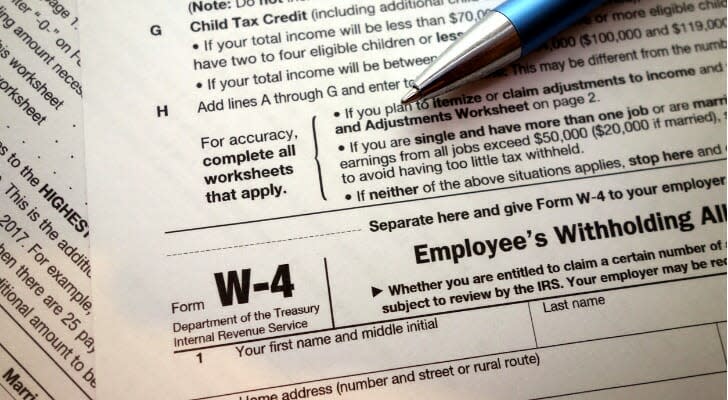What Is a W-4 Form? Here’s Your Simple Guide

After you accept a job offer, your new employer will ask you to fill out a W-4 form. These two-page, fill-in-the-blank style contracts are not nearly as daunting as they may look. In fact, when you complete them honestly and correctly, they may very well end up saving you thousands of dollars come tax day. Here’s how they work.
The Basics of the W-4 Form
The U.S. government requires that every employee in America fill out a W-4 form. Whether you’re a hiring manager or a hopeful new employee, you should understand the basics of the form. You’ll want to have a handle on its purpose and the information it contains before you sign on the dotted line.
The W-4 is an IRS form whose official name is the Employee’s Withholding Allowance Certificate. When completed correctly, the W-4 seamlessly informs an employer of how much money it should withhold from an employee’s paycheck for federal taxes. In turn, the W-4 form also dictates how much money an employee can expect to take home each payday. (You can also check in on this via SmartAsset’s free paycheck calculator.) To represent your financial situation most accurately, the IRS recommends filling out a new W-4 form each calendar year. You should also complete a new one any time your personal finance situation changes in a significant way.
What is Federal Withholding Tax?
The “withholding tax” refers to the money that comes out of your paycheck once you’ve filled out your W-4 form. Also known as “payroll withholding,” the withholding tax is more specifically the income tax that an employer deducts from your wages and gives directly to the IRS. Because your company transfers the money straight to the IRS—rather than siphoning it from your paycheck after you earn it—this maneuver has another nickname: “pay-as-you-earn” taxation.
Breakdown of the W-4 Form

The form itself is relatively short (two double-sided pages), but it’s essential to fill out every section accurately. If you’re not diligent, you’ll likely pay the price.
When you flip open your W-4 form, you’ll find that most of it is comprised of simple tables. They are:
The Personal Allowances Worksheet
The Deductions and Adjustments Worksheet
The Two-Earners/Multiple Jobs Worksheet
These all inform the IRS of your tax situation outside of your job, including your number of dependents. That way, the agency knows exactly what percentage of your income to withhold from every paycheck.
What Are Personal Allowances?
All employees need to fill out the Personal Allowances Worksheet. While fairly straightforward, it pays to understand exactly what to put when listing out your various income details.
In this setting, “allowances” essentially mean deductions. The more allowances listed on the W-4, the less money deducted and given to the IRS. If you’re not sure how many allowances you can claim, don’t worry. The worksheet will walk you through it. It’s fairly easy to work out on your own with the exemptions guide:
Guide to Filling Out Allowances Tax Payer Personal Details What to Put High school or college student You’re unmarried, without kids, younger than 24, and can be claimed as a dependent on your parents’ tax return SINGLE, ZERO ALLOWANCES Employed You have one job, live alone, and are unmarried SINGLE, ONE ALLOWANCE Single parent Claim one allowance for yourself, and one for each child. For example if you’re single with three kids, write… SINGLE, FOUR ALLOWANCES Married, One Spouse Employed You’re married, but only you or your spouse is employed MARRIED, TWO ALLOWANCES Married, Both Employed If you make more money than your spouse, write: MARRIED, [x amount of allowances to cover whole family] Married, Both Employed If you make less money than your spouse, write: MARRIED BUT WITHHOLD AT HIGHER SINGLE RATE, ZERO ALLOWANCES W-4 Responsibilities for the Employer
If you’re a new employee, your main concerns will be honestly filling out the W-4 form before you start work. Of course, you’ll want to be sure to turn in a new copy if anything changes. Updates that you should report on a new W-4 form include getting married or divorced, having a baby, transitioning to part-time employment or buying a house. If you’re an employer, the W-4 requires a different amount of attention.
When you receive a new W-4 form from one of your employees, you need to input the allowances your employee has indicated in your payroll processing system. Every company operates differently, of course, with various organizational systems. Just make sure your interface accurately and effectively withholds the correct amount of federal income tax from your employee’s payroll. If an employee fails to turn in a W-4 form altogether, you must withhold his or her federal income taxes at the highest rate—single filer, with zero allowances.
The Takeaway

As far as IRS tax forms go, the W-4 is among the most straightforward. So long as you fill it out truthfully and draft a new edition with any major life changes, you’re looking at smooth sailing come April. Even so, if numbers aren’t your strong suit, you should use an income tax calculator a few months in advance. That prevents you from getting caught off guard. If you’re feeling extra confident, you can also estimate what your tax returns will be with our tax return calculator.
If you’re still looking to get a stronger grip on your personal finances, find a financial advisor. Check out a matching tool like SmartAsset’s SmartAdvisor to help find a professional who can help you understand your options in the short-term and meet your goals in the long-run.
Photo credit: ©iStock.com/Piotrekswat, ©iStock.com/mediaphotos, ©iStock.com/PeopleImages
The post What Is a W-4 Form? Here’s Your Simple Guide appeared first on SmartAsset Blog.
